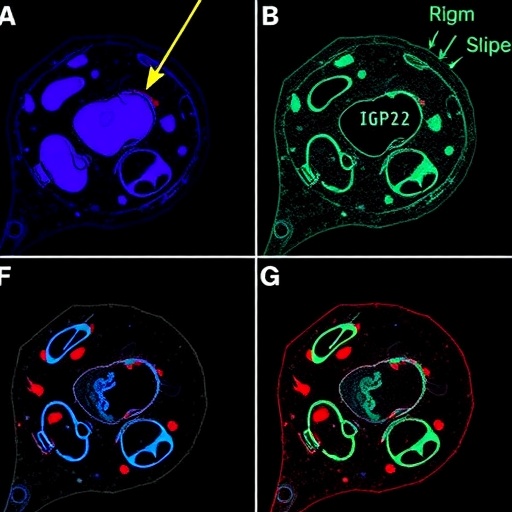In a groundbreaking advancement that promises to reshape our understanding of cancer biology, a team of researchers has unveiled the pivotal role of the insulin-like growth factor 2 mRNA-binding protein 3 (IGF2BP3) in governing the stemness characteristics of salivary adenoid cystic carcinoma (SACC). This malignant tumor, notorious for its relentless progression and poor prognosis, has long challenged oncologists due to its obscure molecular underpinnings. The recent findings, published in Medical Oncology, unlock new vistas in therapeutic strategies by illuminating the pathways through which IGF2BP3 modulates cancer stem cell traits, the key drivers of tumor maintenance, metastasis, and resistance.
At the heart of the study lies an intricate exploration of molecular oncology, where IGF2BP3, an RNA-binding protein, emerges as a master regulator in maintaining the stem-like properties that enable salivary adenoid cystic carcinoma cells to thrive and evade conventional treatments. Cancer stem cells (CSCs) are a sub-population of tumor cells characterized by their ability to self-renew and differentiate, fueling tumor heterogeneity and resilience. Prior research hinted at IGF2BP3’s oncogenic potential, but this study decisively positions it as a crucial orchestrator of these malignant stemness pathways.
Methodologically, the researchers employed a multifaceted approach, combining transcriptomic analyses, knockdown techniques, and functional assays in cell models emblematic of SACC. This comprehensive investigation delineated how IGF2BP3 binds to target messenger RNAs (mRNAs) to stabilize them, thereby augmenting the translation of genes integral to the maintenance of stemness and aggressive phenotypes. By specifically modulating mRNAs involved in self-renewal, proliferation, and survival, IGF2BP3 secures a foothold for cancer stem cells within the tumor microenvironment.
One of the pivotal revelations surrounds the interaction between IGF2BP3 and the well-documented stemness marker NANOG. The team demonstrated that IGF2BP3 enhances the stability of NANOG mRNA, which in turn sustains the transcriptional network required for stem cell renewal. This mechanistic insight elucidates how the cancer maintains a subpopulation of cells primed for perpetuating the malignancy, thereby explaining the notorious resistance of SACC to traditional therapies.
Moreover, the study sheds light on how alterations in IGF2BP3 expression modulate the epithelial-mesenchymal transition (EMT), a biological process crucial for metastatic dissemination. IGF2BP3 upregulation corresponded with enhanced mesenchymal traits and migratory capabilities in SACC cells, providing a molecular rationale for the tumor’s invasive potential. This dual impact — sustaining stemness and promoting EMT — situates IGF2BP3 as a linchpin connecting tumor growth with metastasis.
Importantly, targeting IGF2BP3 using RNA interference technologies yielded a significant reduction in tumor sphere formation and in vitro self-renewal capacity, underscoring the protein’s functional necessity in maintaining the CSC pool. These results not only validate IGF2BP3 as a promising therapeutic target but also propose a novel intervention axis to dismantle the tumor’s regenerative machinery.
The clinical implications of these findings are profound. SACC often presents with perineural invasion and unpredictable therapeutic responses, partially attributed to the elusive CSCs. By intercepting IGF2BP3-mediated pathways, oncologists may be able to curtail the tumor’s regenerative potential, enhancing susceptibility to chemotherapeutic agents and decreasing relapse rates. This approach aligns with the emergent paradigm in oncology focusing on eradicating the root of malignancy — the cancer stem cells — rather than merely reducing bulk tumor mass.
Furthermore, the correlation of IGF2BP3 expression with patient prognosis highlights its potential as a biomarker for aggressive tumor behavior. Immunohistochemical analyses of tumor samples indicate that elevated IGF2BP3 levels predict poorer survival outcomes, suggesting its utility in stratifying patients for personalized treatment regimens. Such prognostic markers are invaluable in tailoring interventions to patient-specific tumor biology.
At a broader scientific level, the study exemplifies the power of RNA-binding proteins in the post-transcriptional control of gene expression, a frontier that has gained considerable attention in recent years. IGF2BP3’s role in modulating mRNA fate highlights the complexity of oncogenic networks beyond genetic mutations, emphasizing the significance of epigenetic and post-transcriptional regulators in cancer stemness and progression.
The research also opens fertile ground for drug discovery endeavors aimed at small molecule inhibitors or antisense oligonucleotides targeting IGF2BP3. Given the protein’s RNA-binding function, structure-based design of compounds that disrupt its interaction with crucial mRNA targets could herald a new class of anti-cancer therapeutics. Such precision medicines could deliver highly specific cytotoxicity towards CSCs while sparing normal tissue stem cells.
Collaboration across disciplines, from molecular biology to clinical oncology, is poised to accelerate the translation of these discoveries into tangible patient benefits. Future investigations are warranted to validate IGF2BP3-targeted therapies in animal models and clinical trials, exploring combinatory regimens that integrate IGF2BP3 inhibition with existing chemotherapies or immunomodulatory approaches.
Beyond salivary adenoid cystic carcinoma, the elucidated mechanisms may have relevance across diverse malignancies where IGF2BP3 is aberrantly expressed, such as pancreatic, lung, and ovarian cancers. This universality could amplify the impact of the findings, positioning IGF2BP3 at the forefront of cancer stem cell research and therapeutic innovation.
In conclusion, the study conducted by Xie, Lu, Wang, and colleagues marks a seminal contribution to cancer biology, elucidating how IGF2BP3 choreographs the stemness traits intrinsic to the insidious nature of salivary adenoid cystic carcinoma. By unraveling this intricate molecular crosstalk, the research paves the way for next-generation targeted therapies aimed at eradicating the most resilient and dangerous components of tumors. The prospect of transforming patient outcomes through precision disruption of cancer stemness is no longer a distant aspiration but an emerging reality on the horizon of oncological research.
Subject of Research: The role of IGF2BP3 in modulating stemness traits in salivary adenoid cystic carcinoma.
Article Title: Deciphering the crucial role of IGF2BP3 in modulating stemness traits of salivary adenoid cystic carcinoma.
Article References:
Xie, H., Lu, L., Wang, S. et al. Deciphering the crucial role of IGF2BP3 in modulating stemness traits of salivary adenoid cystic carcinoma. Med Oncol 42, 513 (2025). https://doi.org/10.1007/s12032-025-03068-7
Image Credits: AI Generated




